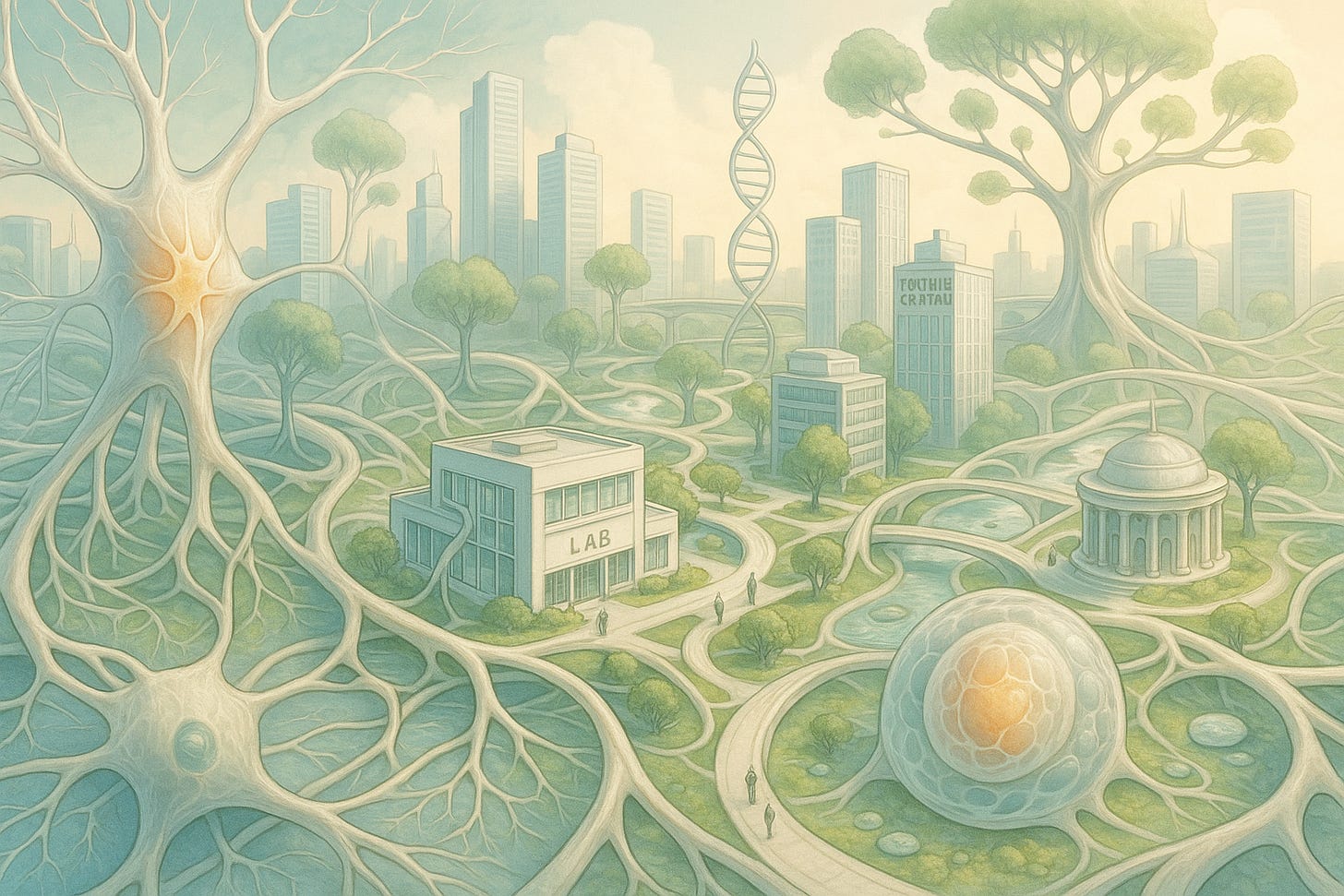Welcome to Systems Biotech
Understanding biotech as a living system shaped by discovery, capital, and culture.
"Biotech" is quite a loaded term.
Depending on the reader and their background, it can evoke a scientific discipline, an enterprise, or a marketplace of speculative drugs. In this publication, I’d like to introduce a different perspective of biotech; one that connects all these concepts (and more) under a single unifying framework.
Biotech is a living system.
I see the biotech industry as a sort of living metabolic organism and when I use the term "living" here, I'm not just seeding some fancy metaphor. Rather, I’m drawing from my scientific understanding of how physical matter can become imbued with the fascinating quality we call life under the right conditions.
What makes a system living?
As living systems ourselves, we humans are quite familiar with the material distinction between living and non-living. It’s fairly obvious to us that our pets, loved ones, and amoebas categorically operate quite differently than a pile of bricks or a cup of water. Beyond this intuition, I think it’s worth introducing a slightly more formal distinction that will serve to motivate this publication moving forward.
Living and non-living can be classified by two key properties:
Thermodynamic openness — whether they exchange both energy and matter with their environment.
Mode of assembly — whether their structure is passively imposed from outside, or actively generated from within.
Non-living systems are typically thermodynamically closed and externally assembled: they exchange energy but not matter, and any structure they exhibit arises passively from environmental forces. Living systems, by contrast, are thermodynamically open and self-assembling: they continuously exchange both energy and matter with their environment and actively maintain, regulate, and rebuild their internal organization.
To make this concrete, consider a rock. A rock absorbs and releases heat depending on the sun’s intensity, but its form emerges passively over time through weathering, erosion and deposition. Its structure reflects the historical imprint of external conditions, not an internal effort to sustain itself. If the rock were alive, it would not merely endure environmental change; it would be thermodynamically driven to sense perturbations, siphon resources, reorganize its structure, and adapt its function to maintain its integrity and persist across time.
The biotech ecosystem is a self-assembling system that openly exchanges knowledge, capital, products, persons and culture with its environment. It is a system where new structures continuously form, grow, collapse, and reorganize under pressures from scientific discovery, market competition, funding landscapes, regulatory environments, and societal trust.
Systems Biotech is a sandbox to model, map, and navigate this fundamental reality.
Why “Systems” Thinking in Biotech?
If you accept (or are eventually convinced after reading more posts in Systems Biotech) that biotech behaves as a living system that is thermodynamically open, self-organizing, and dynamically evolving, then a systems-style of thinking becomes not just helpful, but essential.
In living systems, significance doesn’t reside in isolated parts. It emerges from relationships: the flows of energy, matter, and information that shape structure and function across scales. Metabolism isn’t just about molecules, it’s about their coordinated transformations in response to their chemical environment. Evolution isn’t just about genes, it’s about environmental pressures, adaptive populations and ecological networks.
Similarly, the biotech industry isn’t merely a set of patents, drugs, or clinical trials. It is a dynamic network of interactions, e.g.
foundational science and venture capital
clinical innovation and public policy
emerging technologies and cultural narratives
From a systems way of thinking, these interactions are not peripheral. In fact, their existence are what constitute the system. By viewing biotech as a living system, we gain access to a reservoir of concepts and analytical tools that allow us to better anticipate its future directions, identify critical bottlenecks, and pinpoint transformative opportunities.
This is the heart of Systems Biotech — modeling, analyzing, and navigating this living ecosystem to surface insights for scientists, founders, investors, policymakers, and AI agents.
What You Can Expect
Posts here will consistently reflect a few core principles:
Systems-Oriented: Focuses on the networked interactions of discovery, capital, and culture.
Scientifically grounded: Draws from systems biology, computational modeling, and thermodynamics.
Strategically Insightful: Applies firsthand experience building and scaling scientific ventures.
Future-Focused: Less about reporting what’s happening, more about modeling what could.
Topics will range from metabolic networks to venture capital ecosystems, network medicine to regulatory dynamics, synthetic biology to societal narratives on health and enhancement, but they will always drawn to a single attractor point:
Biotech is a living system, shaped by discovery, capital, and culture.
An Invitation
If you see potential in viewing biotech not as a linear sequence of breakthroughs, but as a dynamic, evolving ecosystem — welcome. Systems Biotech is your place. Subscribe to engage, explore, and help shape the living architecture of biotech. 🚀



Just made a few edits. 🤌